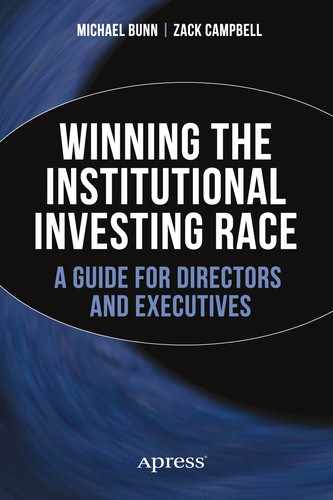When You Don’t Know What to Do
Things done well and with a care, exempt themselves from fear.
—William Shakespeare
Uncertainties can paralyze decision-making, or, even worse, compel investors to base their actions on gut feelings and little else. Uncertainty and fear can’t be analyzed away. You are not trying to develop the best solution to one or even two events for your portfolio, but a good solution to many events. Then adapt as things develop over time. Using the simulation method, you balance simplicity and relevance by considering a likely set of events and the reaction to them by your managers, plus a likely set of outlier events and your possible responses to them. Experience and an understanding of the managers’ histories guide the analysis. Knowing and tracking changes in the inputs (managers) is the most important part, and the only way you can be assured of a reasonable outcome. By considering only the most relevant factors to success, your investment officer is able to manage the complexity of the analysis, save time and identify the leeway they can give to each manager. In the end, they are investing for the next period, not reacting to the last.
Starting with a set of “good” managers to construct your portfolio and building the portfolio as we have discussed, you will have created a baseline or foundation portfolio. Keeping your eye on those risks that may impact your goal, and allowing yourself to adapt to change, you can be assured that you can be successful in the midst of chaos. You will always know what to do, because you have a plan—a base portfolio.
This is where the difference between governing models using an investment office, using a consultant, or especially doing it yourself becomes apparent. When a fund uses an investment officer (whatever his or her strategy for investing is) they get a planned long-term strategy, a baseline that can be used to accomplish a certain goal. That investment officer is personally and continuously invested in the performance and the progress toward the goal(s). The investments are coordinated, and tend to work with each other. Interrelated risks can be evaluated and managed. The board can focus on governance and evaluation.
When things are in chaos, when there is proverbial blood in the streets, when you are uncertain and don’t know what to do, your baseline portfolio does. That baseline portfolio is the place to be. The simulation to develop a distribution of possible returns showed you that there could be, and that there are, times of extreme returns, but that over time the compound average will approach its mean, or at the very least the returns over time will exceed your required return. Each individual manager is dealing with the problems in a small subset of investments using the skill you hired. You layered the portfolio with protections (hedges) for these and even more extreme events. Trust that the line will hold. Decisions made in a calm, deliberative, and unstressed manner will outperform decisions made under stress and without deliberation. That is why good pilots think through their reaction to inflight emergencies on the ground, when they can work through the knock-on issues, and why well-run investment portfolios have a plan.
Holding to your baseline portfolio when frightened, uncertain or lost is simply the best and only solution. One large fund failed to hold to their baseline portfolio just after the debacle in the markets of 2008. Frightened for their reputations if they did not have the funds to complete a building program, they bailed. They sold everything liquid and put it into short-term bonds. This move cost $87 million in the first year, and because they were unwilling to either admit a bad move or fix it or to “time” the markets (neatly forgetting they had already done so), they lost $200 million over the next three years. Unfortunately, they were not the only ones to do so; many other foundations have done the same or similar things.
Part of the initial decision of portfolio strategy is often not deliberated or even consciously made. It is this decision that later causes much of the discomfort as the market or economy changes. There are two points of attitude toward a fund and its planed performance. The first is called “maxi-max” and is the intention or attitude that maximum effort should be made to maximize returns. The second, called “maxi-min,” is that maximum effort should be made to minimize risk (loss). One works great until a big drop in the fund, and the other works until the board sees others with huge profits. At those points of inflection, the pressure is to switch to the other variant, and of course this is often a big mistake. A path in between, a middle road, is often the best, and is easiest to maintain in crisis. That middle road is your baseline portfolio. It will give you strong performance, although perhaps not the very top performance, and will help you minimize loss, although again perhaps not as small as some. In the long run, this baseline portfolio will ensure you have a corpus that will support current and expanded programs or an expanding share of budget support.
Realize that investment is risky, and some amount of risk is appropriate and that some amount of return is also appropriate. Planning for and building a portfolio to accomplish this and then holding to the plan at those crisis points will be the most successful path.
